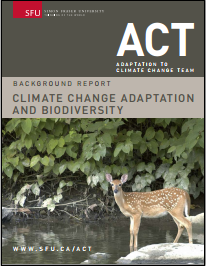Climate Change Adaptation and Biodiversity


Introduction
The Intergovernmental Panel on Climate Change (IPCC) confirms that “most of the observed increase in global average temperatures since the mid-20th century is very likely due to the observed increase in anthropogenic greenhouse gas concentrations”.1 Furthermore, the IPCC concludes, climate change has begun and is projected to exert additional pressures on all features of biodiversity.2 Biological diversity is essential to maintaining ecosystem functions that provide vital support systems that in turn sustain all human, plant, and animal life and the socioeconomic systems that sustain all human life. Climate change in conjunction with existing human-driven stressors poses a significant threat to the state of biological diversity and ecosystem functions in British Columbia. This hazard forces us to fundamentally change the approach we use to manage our natural capital assets such as our forests, grasslands, wetlands, and alpine regions, along with our living and working environments such as our cities, towns, and working landscapes. Exploring the linkages between climate change and biodiversity is an important endeavour for three reasons. First, biodiversity provides a suite of valuable direct and indirect economic benefits to human societies, such as life support systems and the provision of material goods and services. Second, human enterprise has been exerting enormous pressure on our natural environment, resulting in an extraordinary loss of biodiversity and its ability to sustain ecosystem functions, and climate change will likely increase the strain on existing vulnerable systems. Third, BC is Canada’s most biologically diverse province, featuring over 3600 species and subspecies, of which over 1/3 are listed as endangered, threatened, or species of concern.3
Mitigation and adaptation are the two broad policy responses that address sources contributing to climate change and their related impacts. Mitigation refers to policy measures that stabilize or reduce atmospheric concentration of greenhouse gases (GHGs) to levels that do not dangerously interfere with the climate system. Adaptation refers to adjusting or accommodating to climate change-induced impacts, which includes minimizing negative consequences and enhancing opportunities. Adaptation responses are essentially planned or unplanned policy responses designed to increase the resiliency of our natural, socioeconomic, and built environments. Adaptation is becoming an increasingly important public policy response for two reasons. First, even if mitigation measures achieve successful reductions in human-caused GHG emissions, the excessive concentration of GHGs already in the atmosphere will continue to force changes to climatic conditions and alter the state of biodiversity in BC over the course of the next century.4 Second, the current structure of BC’s governance framework responsible for managing land and natural resources does not effectively address the impending challenges of climate change-induced impacts on our natural, human, and built environments.
This report synthesizes information compiled from input contributed by ACT’s Communities in Jeopardy: Plant, Animal and Human conference participants in April 2008, along with a review of publications from leading authorities researching climate change impacts on biodiversity, and adaptation responses. The purpose of this report is to provide a background summary on the following points of discussion:
- Observed and projected climate changes in BC;
- Observed and expected climate change-induced impacts on biodiversity in BC and northern temperate regions;
- An overview of the state of biodiversity in BC;
- A discussion on the link between biodiversity, ecosystem functions, and the value of natural capital;
- An overview of vulnerable natural and socioeconomic systems in BC;
- An outline for a general adaptation framework that addresses ecosystem resiliency and examines the challenges and opportunities associated with launching adaptation measures in BC.
We intend to use this synthesis of information as a background document to substantiate ACT’s policy recommendations addressing the need to restructure BC’s land and resource governance framework, with the ultimate goal of increasing ecosystem and community resiliency against the current and projected climate change impacts on biodiversity.
Footnotes
1 IPCC (2007)
2 Gitay, H., Suárez, A., Watson, R.T., Dokken, D.J. (2002)
3 David Suzuki Foundation and Sierra Legal (2007). This number is a gross underestimate that does not include poorly understood and inventoried species such as fungi, lichens, and most insects. The report excludes populations, marine species, non-vascular plants, accidentals, introduced species, and species listed as no status by the BC Conservation Data Centre. Austin, M.A., et al. (2008) estimate over 50 000 species reside in BC but only 3800 of them have been assessed for their conservation status.
4 Gayton, D. (2008)
Citation
Kimmer, E., 2009. Climate Change Adaptation and Biodiversity: Background Report. Available at http://act-adapt.org/biodiversity/
- View ACT’s recommendations for policy
- Read more about ACT’s work on Climate Change and Biodiversity here
(0) Comments
There is no content